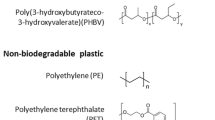Abstract
Stenothermic cold adaptation was a predominant growth characteristic among biopolymer degrading bacteria from Antarctic shelf sediments. Psychrophilic decomposers of protein (gelatin), chitin, and cellulose accounted for up to 84, 93, and 68%, respectively, of 0°C-isolates from selected compartments of the sediments. Macroinvertebrates were recognized as a selective pressure on these fast-growing (zymogenous) psychrophiles. Psychrophilic properties of growth and biopolymer degradation coincided most in the case of proteolytic isolates. On the other hand, the majority of psychrophilic chitin- and cellulose-decomposers showed less efficient biopolymer degradation at environmental temperatures (0°C). Temperature optima of the activities of pertinent depolymerizing enzymes (e.g., scleroprotease) exceeded by far the temperature optima for growth (between 4 and 12°C). Therefore, it appears likely that enhanced rates of enzyme synthesis at low temperatures play a crucial role for the degradation of detrital organic matter in this permanently cold environment.
Similar content being viewed by others
References
Aller JY, Aller RC (1986) Evidence for localized enhancement of biological activity associated with tube and burrow structures in deep-sea sediments at the HEBBLE site, western North Atlantic. Deep-Sea Res 33:755–790
Baross JA, Monta RY (1978) Microbial life at low temperatures: ecological aspects. In: Kushner DJ (ed) Microbial life in extreme environments. Academic Press, London, New York, San Francisco, pp 9–71
Clarke A (1979) On living in cold water: k-strategies in Antarctic benthos. Mar Biol 55:111–119
Colwell RR, Liston J (1962) The natural bacterial flora of certain marine invertebrates. J Ins Pathol 4:23–33
Dell RK (1972) Antarctic benthos. Adv Marine Biol 10:1–216
Deming JW, Tabor PS, Colwell RR (1981) Barophilic growth of bacteria from intestinal tracts of deep-sea invertebrates. Microb Ecol 7:85–94
Ellwood DC, Keevil CW, Marsh PD, Brown CM, Wardell JN (1982) Surface-associated growth. Philos Trans R Soc Lond (Biol) 297:517–532
Ferroni GD, Kaminski JS (1980) Psychrophiles, psychrotrophs, and mesophiles in an environment which experiences seasonal temperature fluctuations. Can J Microbiol 26:1184–1191
Fry JC (1982) Interactions between bacteria and benthic invertebrates. In: Nedwell DB, Brown CM (ed) Sediment microbiology. Academic Press, London, New York, pp 171–201
George RY (1977) Dissimilar and similar trends in Antarctic and Arctic marine benthos. In: Dunbar MJ (ed) Polar oceans. Arctic Institute of North America, Calgary, Alberta, pp 391–407
Godshalk GL, Wetzel RG (1977) Decomposition of macrophytes and the metabolism of organic matter in sediments. In: Golterman HL (ed) Interactions between sediments and freshwater. Dr W Junk BV Publishers, The Hague, pp 258–264
Gow JA, Mills FHJ (1984) Pragmatic criteria to distinguish psychrophiles and psychrotrophs in ecological systems. Appl Environ Microbiol 47:213–215
Harder W, Veldkamp H (1971) Competition of marine psychrophilic bacteria at low temperatures. Antonie van Leeuwenhoek. J Microbiol Serol 37:51–63
Hodson RE, Azam F, Carlucci AF, Fuhrman JA, Karl DM, Holm-Hansen O (1981) Microbial uptake of dissolved organic matter in McMurdo Sound, Antarctica. Mar Biol 61:89–94
Holm-Hansen O, Azam F, Carlucci AF, Hodson RE, Karl DM (1977) Microbial distribution and activity in and around McMurdo Sound. Antarctic J 12:29–32
Inoue K (1976) Quantitative ecology of microorganisms of Syowa station in Antarctica and isolation of psychrophiles. J Gen Appl Microbiol 22:143–150
Inoue K, Komagata K (1976) Taxonomic study on obligately psychrophilic bacteria isolated from Antarctica. J Gen Appl Microbiol 22:165–176
Jones GW (1984) Mechanisms of the attachment of bacteria to animal cells. In: Klug MJ, Reddy LA (eds) Current perspectives in microbial ecology. ASM, Washington, DC, pp 136–143
Kaneko T, Krichevsky M, Atlas RM (1979) Numerical taxonomy of bacteria from the Beaufort Sea. J Gen Microbiol 110:111–125
Leduc LG, Ferroni GD (1979) Quantitative ecology of psychrophilic bacteria in an aquatic environment and characterization of heterotrophic bacteria from permanently cold sediments. Can J Microbiol 25:1433–1442
Little JE, Sjogren RE, Carson GR (1979) Measurement of proteolysis in natural waters. Appl Environ Microbiol 37:900–908
Morita RY (1975) Psychrophilic bacteria. Bacteriol Revs 39:144–167
Morita RY, Burton SD (1970) Occurrence, possible significance, and metabolism of obligate psychrophiles in marine waters. In: Hood DW (ed) Organic matter in natural waters. Publication No. 1, Institute of Marine Science, University of Alaska, Fairbanks, pp 275–285
Morita RY, Griffith RP, Hayasaka SS (1977) Heterotrophic activity of microorganisms in Antarctic waters. In: Llano GA (ed) Adaptations within Antarctic ecosystems. 3rd SCAR/ IUBS Symp on Antarctic Biology, Gulf Publishing Co, Houston, pp 99–113
Norkrans B, Stehn BO (1978) Sediment bacteria in the deep Norwegian Sea. Mar Biol 47: 201–209
Reichardt W (1975) Bacterial decomposition of different polysaccharides in a eutrophic lake. Verh Intl Verein Limnol 19:2636–2642
Reichardt W (1979) Influence of temperature and substrate shocks on survival and succinic dehydrogenase activity of heterotrophic freshwater bacteria. Water Res 13:1149–1154
Reichardt W (1986) Enzymatic potential for decomposition of detrital biopolymers in sediments from Kiel Bay. Ophelia 26:369–384
Reise K (1981) High abundance of small zoobenthos around biogenic structures in tidal sediments of the Wadden Sea. Helgoländer Meeresuntersuchungen 34:413–425
Rüger HJ (1982) Psychrophilic sediment bacteria in the upwelling area off NW Africa. Naturwissenschaften 69:448
Sarayuma H, Fukunaga N, Sasaki S (1980) Effect of low temperature on protein-synthesizing activity and conservability of polysome in bacteria. J Gen Appl Microbiol 26:45–50
Sieburth JMcN, Dietz AS (1974) Biodeterioration in the sea and its inhibition. In: Colwell RR, Monta RY (eds) Effect of the ocean environment on microbial activities. University Park Press, Baltimore, pp 318–326
Sochard MR, Wilson DF, Austin B, Colwell RR (1979) Bacteria associated with the surface and gut of marine copepods. Appl Environ Microbiol 37:750–759
Wiebe WJ, Hendricks CW (1971) Simple, reliable cold tray for the recovery and examination of thermosensitive organisms. Appl Microbiol 22:734–735
Yingst JY, Rhoads DC (1980) The role of bioturbation in the enhancement of bacterial growth rates in marine sediments. In: Tenore KR, Coull BC (eds) Marine benthic dynamics. University of South Carolina Press, Columbia, SC, pp 407–421
Author information
Authors and Affiliations
Rights and permissions
About this article
Cite this article
Reichardt, W. Impact of the Antarctic benthic fauna on the enrichment of biopolymer degrading psychrophilic bacteria. Microb Ecol 15, 311–321 (1988). https://doi.org/10.1007/BF02012644
Issue Date:
DOI: https://doi.org/10.1007/BF02012644




